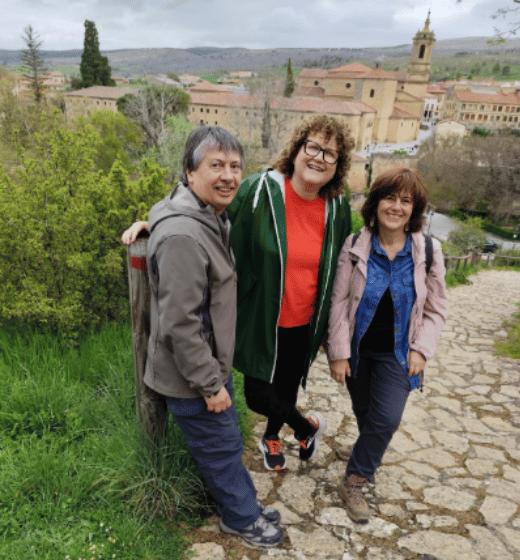

Some people think you have to travel to Latin America to get ready for a trip there. I say spend a week with me in Burgos first, and you’ll see how quickly your Spanish can take off.
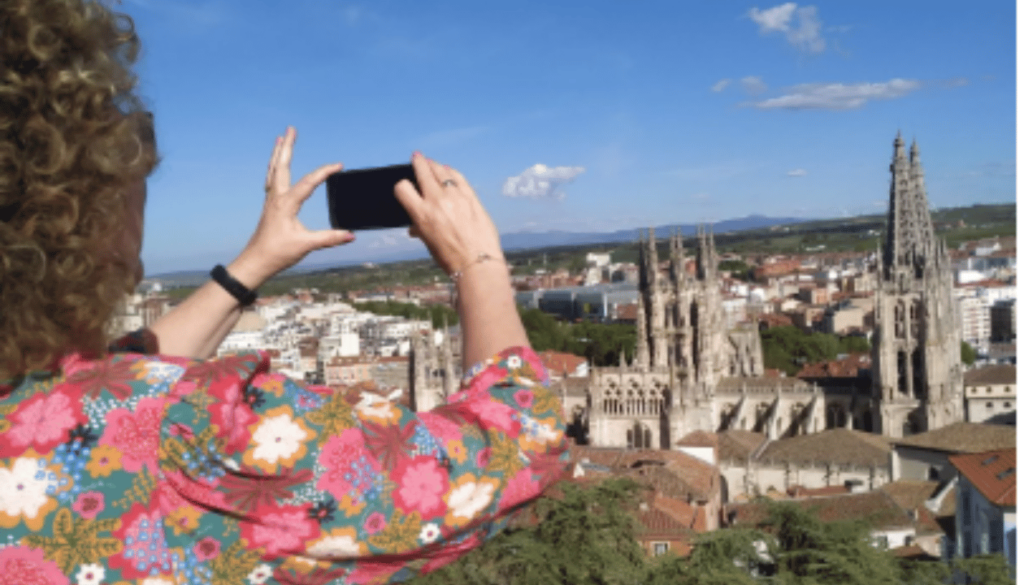
In April, my wife, Marisol, and I had the pleasure of hosting Belinda, a British traveler with big plans to explore Latin America the very next year. She joined us for the Spanish Homestay Immersion Program (SHIP), eager to enhance her language skills before embarking on her adventure abroad.
Belinda isn’t a typical teenager on a school trip or a retiree with free time—she’s a curious explorer in her 60s who loves history, hiking through nature, and tasting local foods wherever she goes. With a trip across Spanish-speaking countries on the horizon, she wanted to do more than just review grammar rules; she wanted to live the language.
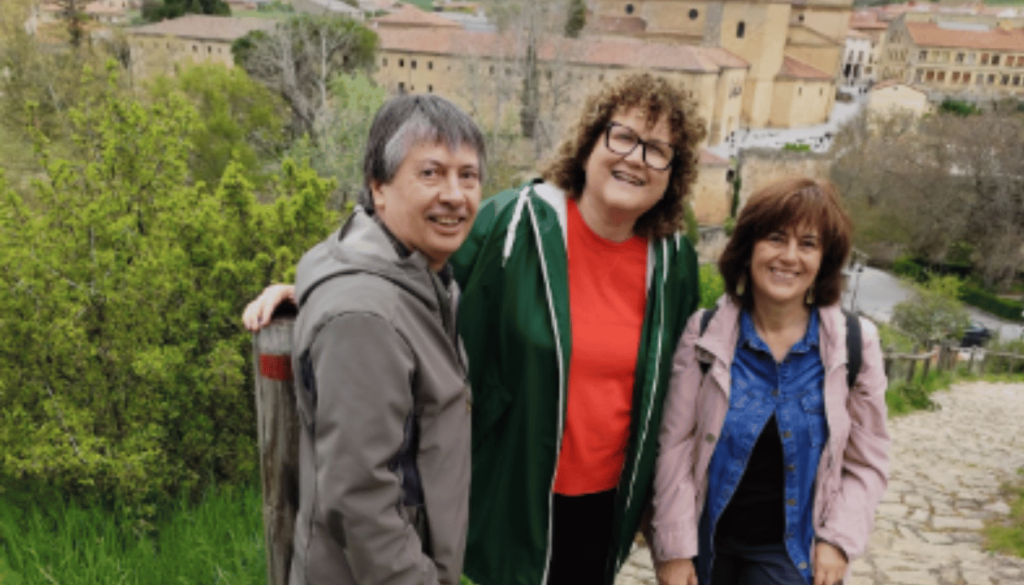
Who Am I?
I’m Alberto, a native Spanish teacher with Spanish Express in Burgos. Along with my fellow teacher (and wife), Marisol, I make sure our students don’t just study Spanish. They experience it every moment of the day.
Burgos, our hometown, is one of the cities where Spanish is spoken most clearly. It also boasts three UNESCO World Heritage sites: the Gothic Cathedral of Burgos, the Camino de Santiago route that runs through the city, and the nearby Yacimientos Arqueológicos de Atapuerca. In other words, Burgos is a living classroom, full of history and culture, and it was the perfect place for Belinda to immerse herself in Spanish.
Belinda’s Arrival
Belinda arrived with a bit of Spanish under her belt. She’d taken a short course for a week and had some online lessons. But she knew that real confidence comes from using Spanish in everyday life, not just memorizing phrases from a book. Over the week, we combined formal Spanish classes at home with countless conversations out in the city and countryside. The result?
By the end of her stay, Belinda was speaking Spanish with a new ease, ready to chat with anyone from Madrid to Mexico City. Here’s a look at how a week in Burgos helped transform her Spanish, one day at a time.
We Walked the Camino Through Historic Burgos

Stepping onto the Camino: Spanish in Motion
Our first day was all about getting to know Burgos and warming up Belinda’s Spanish in real settings. After a morning Spanish class at home, we stepped outside and literally onto the Camino de Santiago – the famous pilgrimage route that runs right past our building.
Belinda was thrilled to learn that she was walking the same path pilgrims have taken for centuries on their way to Santiago de Compostela. We had talked about the history of the Camino earlier, and now she could see it (and walk it) firsthand. She even greeted a few backpack-toting pilgrims with a friendly “¡Buen camino!” as they passed.
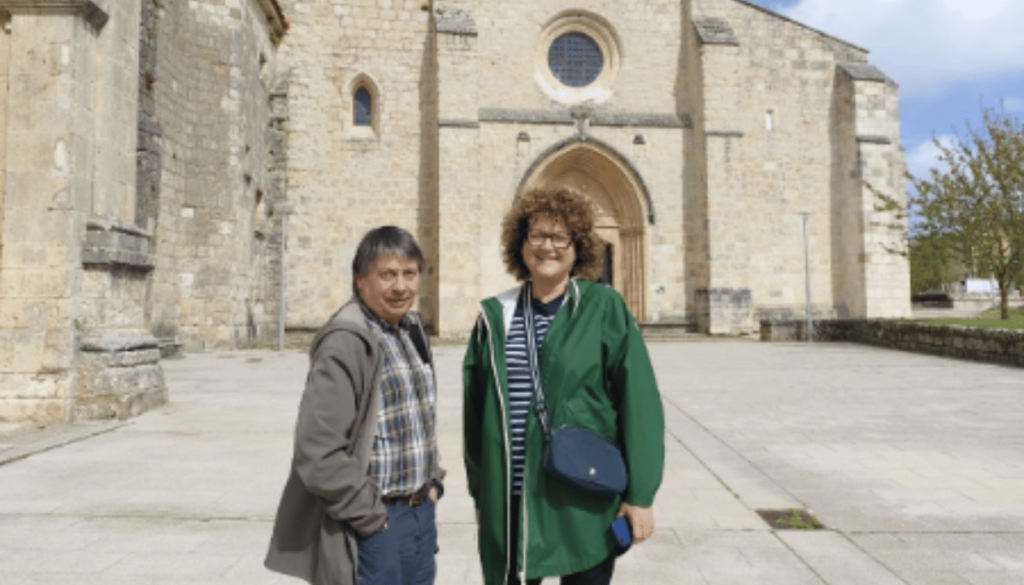
Legends and Language in the Heart of the City
In the afternoon, we dove into Burgos’s historic center. We started at the statue of El Cid, the city’s legendary 11th-century knight. Standing beneath that bronze hero, I shared stories of his adventures and his role in the Reconquista, and Belinda listened intently, picking up new words like caballero (knight).
From there, we strolled under the shade of the trees along the Paseo del Espolón, a beautiful riverside promenade, until we reached the Arco de Santa María. This grand stone gate was once the main entrance to the medieval city, and it still looks like something out of a fairy tale.
Belinda was full of questions (in Spanish!) about the old city walls and the nobles and pilgrims who must have passed through that very gate. I answered them all, delighted to see her curiosity blooming in Spanish.
Castles, City Views, and Grammar in Action
Next, we hiked up the hill to the ruins of the old Burgos Castle. At the top, we were rewarded with a breathtaking panoramic view of the entire city. We could see the Cathedral’s spires piercing the sky and the red-tiled rooftops spread out below. I pointed out the line of the Camino de Santiago stretching off toward the horizon. Belinda took it all in, practicing the past tense in Spanish as she described other great views she had seen in her travels.
On our way down from the castle, we passed the modern art museum (even from outside, its contemporary design was a sharp contrast to all the Gothic and medieval architecture we’d been seeing) and sections of the ancient city wall. Each time we stumbled upon another old gate or a crumbling archway, it was another chance for Belinda to learn a bit of history en español.
Coffee, Conversation, and Camino Reflections
By late afternoon, we figured we deserved a break. We found a cozy café in a little plaza. Belinda confidently ordered dos cafés con leche for us, and we sat outside watching life in Burgos go by. As we sipped our coffee, we noticed a few pilgrims resting nearby with scallop shell charms (the symbol of the Camino) on their backpacks. This sparked a whole conversation in Spanish about pilgrim traditions and the stories of the Camino. It was amazing to see how much Belinda had absorbed in just one day: new vocabulary, local legends, and the easygoing rhythm of Spanish conversation in the heart of an ancient city.
Gothic Splendor and a Home-Cooked Dinner
Stepping Inside Burgos Cathedral
The next day, we switched from medieval streets to majestic heights. After our morning lesson, we headed to the Burgos Cathedral in the afternoon. This cathedral isn’t just big – it’s breathtaking. Construction began in 1221, and it’s one of the most stunning Gothic temples in all of Spain. Inside, every corner begged a question or an explanation (in Spanish, of course!).
We stood in awe at the foot of the Golden Staircase, an ornate spiral staircase that looked as if it belonged in a palace. Belinda asked me about its history and design, and I was happy to explain how it was a Renaissance masterpiece added to a Gothic wonder.
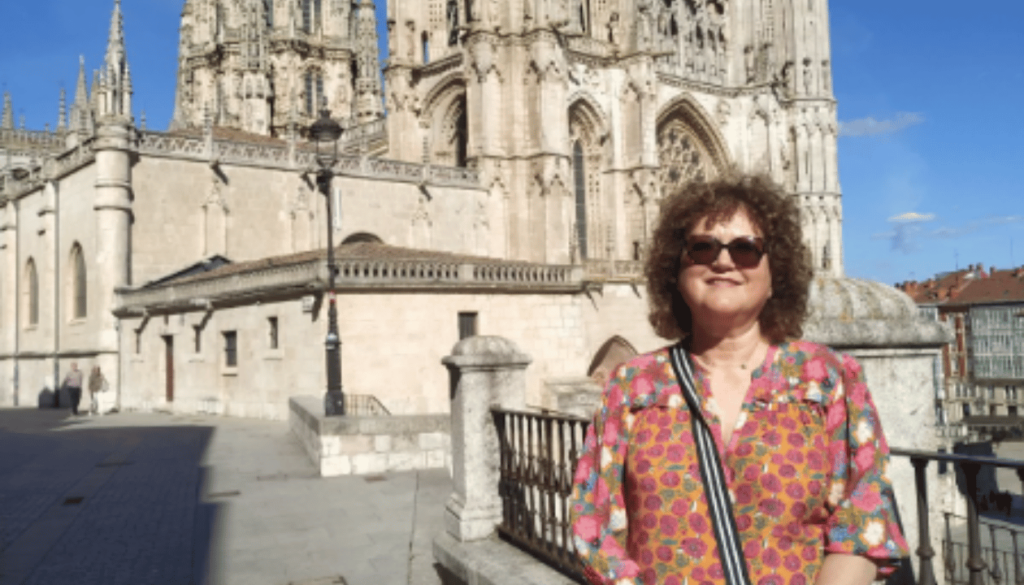
Laughs, Lanterns, and Language Under the Vaulted Ceilings
As we wandered through grand chapels and beneath soaring vaulted ceilings, we made sure to stop by the famous Papamoscas clock. At the stroke of the hour, a little mechanical figure high above us opened its mouth wide to ring the bell – a sight that made Belinda laugh. (I taught her that Papamoscas literally means “fly-catcher,” a funny name that she quickly added to her Spanish vocabulary list.)
We also paused under the cathedral’s magnificent lantern tower, gazing up at the intricate stonework that lets in beams of colored light. Belinda was brimming with curiosity, asking everything from “¿Cómo se dice stained glass en español?” to questions about the old kings and bishops buried there. It turned into a private Spanish-on-the-go tour, with each marvel inside the cathedral sparking new words and mini history lessons.
Reflections and Refreshments with a View
After nearly two hours, we stepped back out into the sunlight and walked around the cathedral’s exterior to admire its spires from different angles. The Arco de Santa María – the same gate we passed the day before was right next door, so we took another moment to appreciate its carved stone façade and even peeked inside its tiny museum.
With our heads full of art and history, we settled down at a nearby bar for a well-earned refresco. Over cold drinks, we chatted about our favorite parts of the cathedral. Belinda told me (in Spanish!) that she couldn’t believe how much detail there was, and we joked that even a week in Burgos might not be enough to see every statue and painting in that place.
Cooking Up Confidence: Spanish in the Kitchen
That night, the cultural immersion continued in our kitchen. Marisol and I decided it was tortilla de patatas time – Spain’s famous potato omelette. Rather than just serve it, we invited Belinda to help us make it. Apron on and frying pan ready, she learned the simple but tricky steps: slicing potatoes and onions thin, cooking them just right, and the biggest challenge – flipping the tortilla without making a mess!
We talked her through it entirely in Spanish: bate los huevos (beat the eggs), añade la sal (add the salt). There were a few tense giggles as Belinda slid a plate over the pan to flip the tortilla, but she pulled it off like a pro. Sitting down to dinner, we all dug into the delicious result.
Belinda was proud – not just of the tortilla (which turned out perfecto), but because she had followed a Spanish recipe and kitchen instructions in Spanish. Cooking together was the perfect recipe for language practice: a pinch of new vocabulary, a dash of laughter, and a very tasty reward at the end!
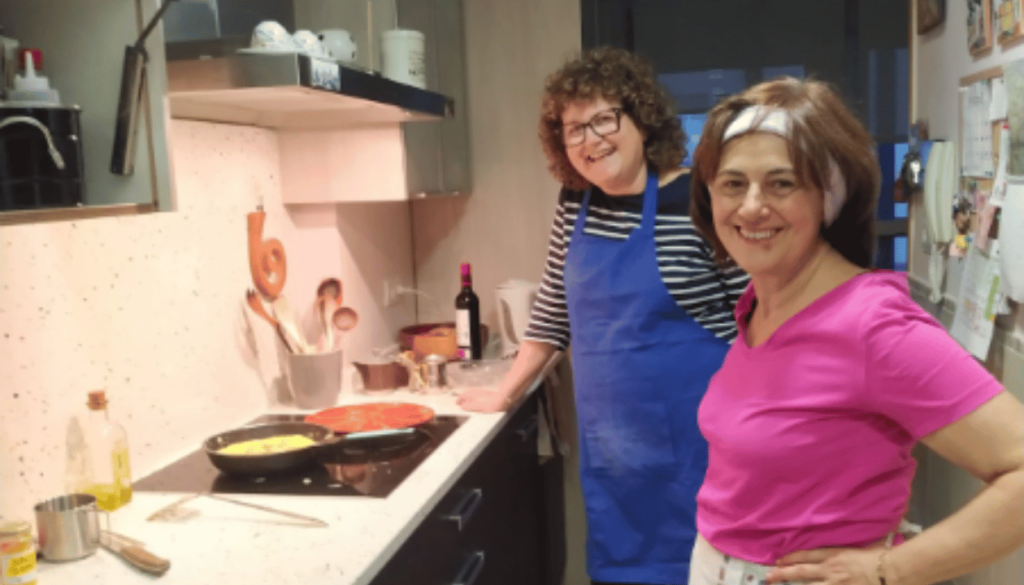
Journey into Prehistory at Atapuerca
A Spanish Lesson in Archaeology
Midweek, we traded the city streets for the ancient past. We took a short drive out of Burgos to visit the Atapuerca archaeological sites, home to some of the oldest human remains ever found in Europe. With a knowledgeable guide leading the way (in Spanish, naturalmente), Belinda and I donned hard hats and stepped into the excavations. It felt like stepping back in time – literally into the trenches where archaeologists have unearthed fossils of our ancestors from nearly 1.8 million years ago.
Bones, Tools, and Questions in Spanish
As we stood there, the guide showed us where various human skull fragments and stone tools were discovered. Belinda listened carefully, and I could see her connecting words like hueso (bone) and fósil (fossil) to the real pieces of prehistory right in front of us.
The guide was impressed that Belinda was following along in Spanish, and even encouraged her to try out a few phrases she’d prepared to ask questions about the dig. She asked about how those ancient people lived and what animals they hunted, turning what could have been a simple tour into a lively Spanish discussion about early human life!
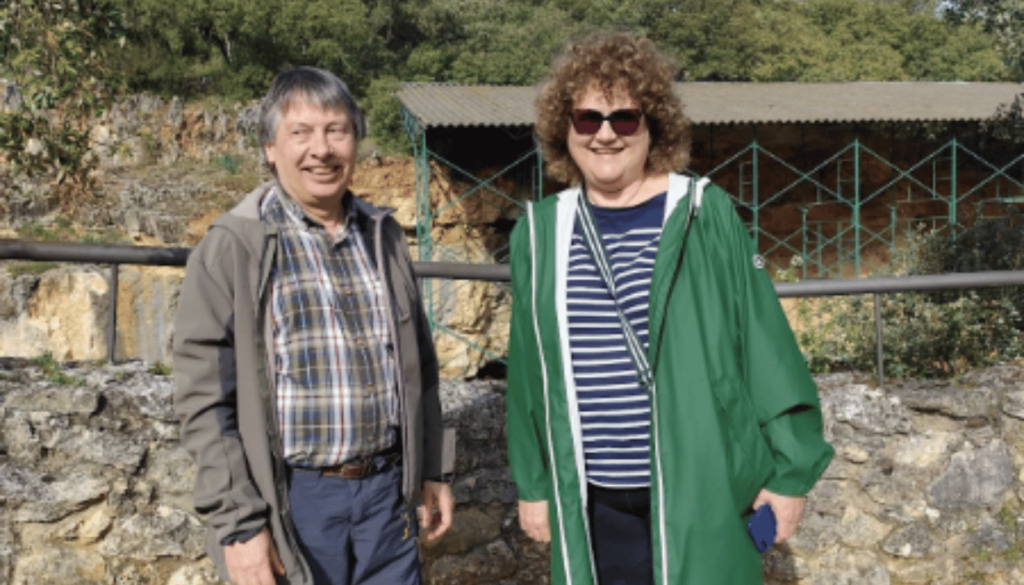
Hands-On History at the CAREX Center
After exploring the dig sites, we visited the CAREX (Centro de Arqueología Experimental), an interactive center where the past comes alive. We tried our hand at some prehistoric skills – throwing spears, grinding grain, and even starting a spark of fire using stones, just like our distant ancestors.
These hands-on activities were not only fun, but they also added a whole new batch of verbs and vocabulary to Belinda’s repertoire. I’ll never forget the sight of Belinda concentrating hard as she said, “¡Estoy intentando hacer fuego!” (“I’m trying to make fire!”) while rubbing two sticks together. We both laughed when a tiny wisp of smoke finally appeared.
Quiet Reflection in San Juan de Ortega
On our way back to Burgos, we made a short stop at San Juan de Ortega, a small village that has been a welcome rest stop for Camino de Santiago pilgrims for centuries. We stepped into its ancient monastery church, where a local caretaker greeted us. In the hushed, cool air of the chapel, we talked quietly about the legend of San Juan (Saint John) and why pilgrims still light candles there for a safe journey.
Belinda took a moment to soak in the peaceful atmosphere, and as we walked out, she commented in Spanish on how connecting with such deep history made her feel even more prepared for her own journey. By the time we got back home that evening, her Spanish skills had traveled from the Stone Age to the Middle Ages all in one day!
From Hollywood to Holy Chants: A Day in the Arlanza Valley
A Road Trip Through Culture, Legends, and Language
By Thursday, it was time to venture further afield. I planned a road trip to show Belinda some of the hidden gems of Burgos province – places where history, legend, and even a bit of Hollywood movie magic awaited us. We hopped in the car early, Spanish radio softly playing, and headed into the Arlanza Valley to explore a few extraordinary spots.
Spaghetti Westerns and Spanish Vocabulary at Sad Hill
First stop: Sad Hill Cemetery. Tucked in a quiet meadow surrounded by hills, this isn’t a real cemetery at all, but the famous film set from the climax of the classic Western The Good, the Bad and the Ugly. As we walked the grounds, I could almost hear Ennio Morricone’s iconic music in the wind. Belinda was astonished that a spaghetti western duel scene was filmed right here in Spain.
We joked in Spanish about our “duel” with the sun as we squinted in the bright light, and she learned fun terms like película del Oeste (Western movie). It was surreal to stand where Clint Eastwood once stood, and it made for a perfect conversation starter about movies and Spanish film locations.
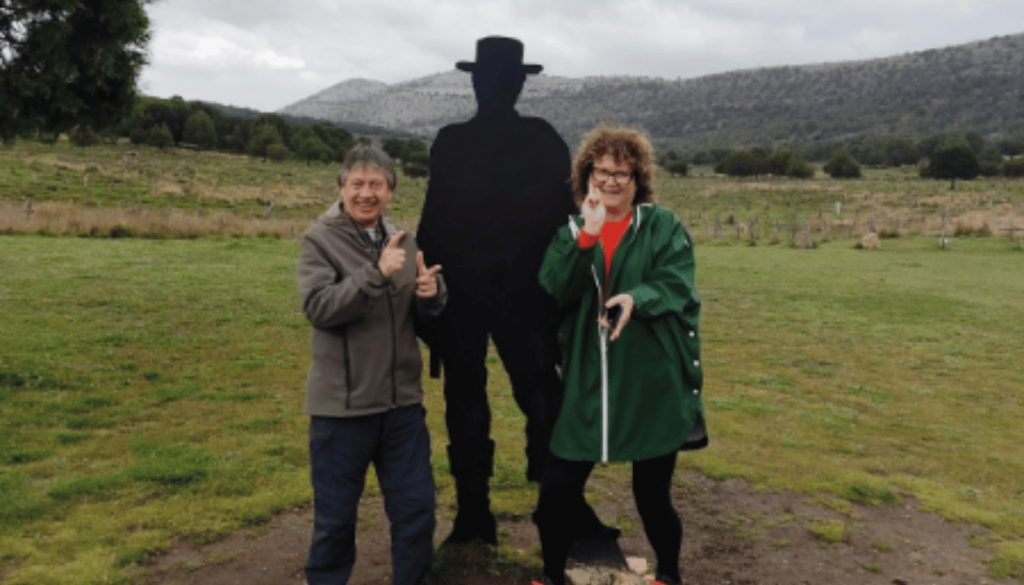
Stone Carvings and Sacred Sounds in Silos
Next, we drove on to the Monastery of Santo Domingo de Silos, nestled in a charming village. This abbey is famous for its Romanesque cloister – a courtyard surrounded by beautifully carved stone columns. We wandered through the cloister, pausing to admire the intricate details on each capital (I explained in Spanish how each carving tells a biblical story or symbolizes a virtue).
In the monastery’s small museum, Belinda asked me about some ancient manuscripts and religious art pieces, expanding her vocabulary with words like monje (monk) and cántico (chant). The highlight, though, was at midday. We took a seat in the church and listened as the Benedictine monks filed in and began to sing Gregorian chant.
The echo of their voices in the centuries-old stone hall gave us both goosebumps. Belinda closed her eyes and whispered, “Es precioso” (“It’s beautiful”), truly moved by the experience. It was a moment of pure culture and calm, and a unique listening exercise for her Spanish, since afterwards we softly discussed how the music made us feel, entirely en español.
Echoes and Adjectives in a Natural Canyon
In the afternoon, we stretched our legs at the Yecla Gorge (Desfiladero de la Yecla). This is a narrow natural canyon where a wooden walkway winds through towering rock walls above a rushing stream. As we carefully made our way along the path, the cool air and dripping water made it feel like we’d entered a hidden world. We practiced some nature vocabulary here – acantilado (cliff), agua (water), and eco (echo) – which was fun as our voices bounced off the tight canyon walls. Belinda was delighted every time she shouted “¡Hola!” and a dozen echoes answered back. It was a short walk, but it added a bit of adventure to our day.
A Princess, a Village, and a Spanish Story Retold
Our final stop on this route was the postcard-perfect village of Covarrubias. Often called one of the most beautiful villages in Spain, Covarrubias welcomed us with half-timbered houses, flower-filled balconies, and cobblestone streets that seem frozen in time. We strolled through the little plaza and down winding lanes, greeting a few locals with buenas tardes as we passed.
I told Belinda the tale of Princess Kristina of Norway, whose statue stands in the village. In the 13th century, she traveled all the way from Norway to marry a Castilian prince, a story of cultural exchange and adventure that resonated with Belinda’s own upcoming travels. Standing by Princess Kristina’s statue, Belinda practiced telling the story back to me in Spanish (with a bit of prompting). Her eyes lit up as she successfully used the past tense to recount how a Norwegian princess became part of Spanish history. It was a proud teacher moment for me, seeing her turn a complex historical anecdote into a Spanish narrative of her own.
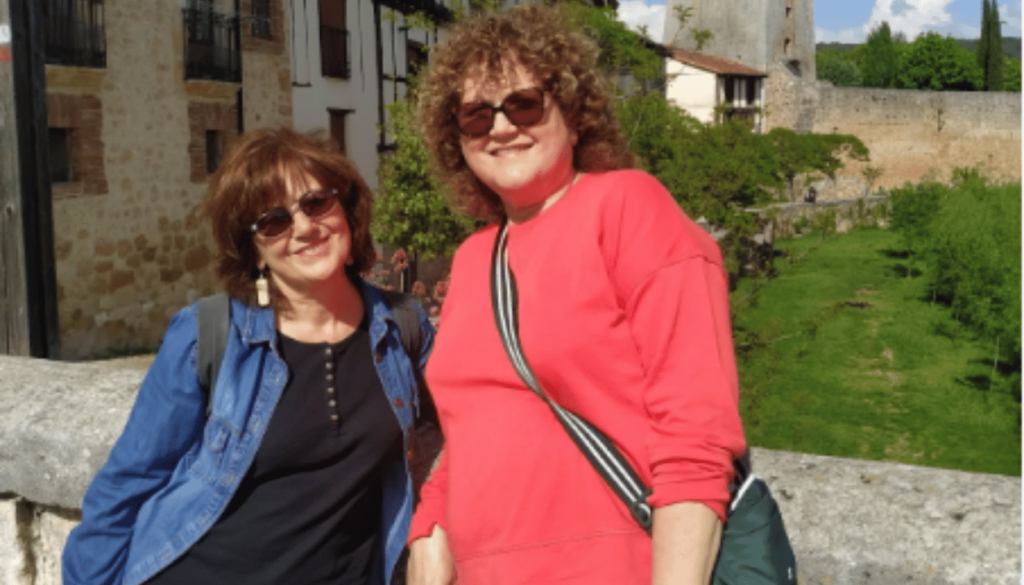
One Day, Many Worlds: Belinda’s Confidence Takes Root
By the time we drove back to Burgos that evening, our day had been filled with so many different worlds. We had experienced a cowboy showdown, sacred chants, natural wonders, and medieval legends. And through it all, Belinda had been speaking, listening, and thinking in Spanish.
This kind of immersive experience, chatting about film scenes one moment and monasteries the next, really solidified her confidence. She joked that if she could handle discussing gun-slingers and Gothic arches in Spanish on the same day, she’d be ready for anything in Latin America!
Connecting the Dots at the Museum of Human Evolution
From the Dig Site to the Display Case
After another morning of lessons at home on Friday, we set out to connect everything we’d learned so far. Our destination was the Museum of Human Evolution (Museo de la Evolución Humana), a modern museum in Burgos that houses many of the incredible findings from the Atapuerca sites. If Atapuerca was the hands-on adventure, this museum was the big picture that tied it all together.
Reading, Recognizing, and Reflecting in Spanish
Inside the sleek, multi-story building, we wandered through exhibits that followed the timeline of human history. We saw life-sized recreations of early human species, displays of stone tools and fossils, and even the real bones of some of the Atapuerca hominids under glass. I encouraged Belinda to read the informational panels out loud softly as we went along.
She was amazed at how much she understood words like prehistoria, evolución, and Homo antecessor jumped out at her as familiar terms from our excursion earlier in the week. Whenever she stumbled on a word, I was right there to help, but more often than not, she was actually telling me interesting facts (in Spanish) that she’d just read on the displays!
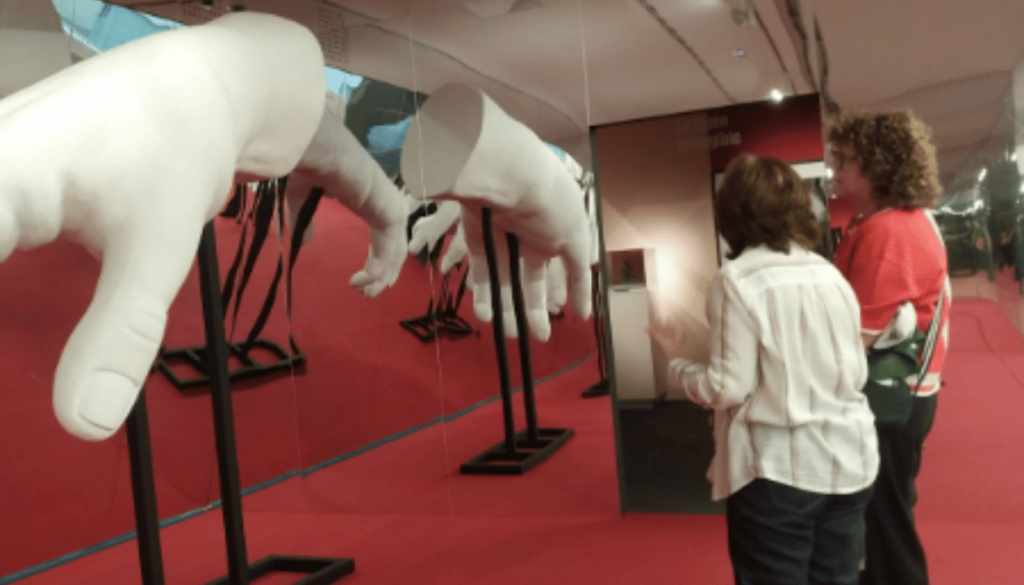
Laughs, Learning, and Distant Cousins
One of Belinda’s favorite parts was an interactive exhibit where you could compare your own face to a Neanderthal’s reconstruction – she giggled and said, “¡Mira, somos primos lejanos!” (“Look, we’re distant cousins!”).
A Final Reflection on Language Through Time
We also took a break to watch a short film (in Spanish) about the discovery of the Atapuerca caves. It was satisfying to see Belinda nodding along, clearly following the storyline. By the end of our museum visit, she remarked that learning Spanish through history made both the language and the science feel more vivid. Standing in front of an ancient skull, she turned to me and said, “Nunca pensé que hablaría de evolución humana en español.” (“I never thought I’d be talking about human evolution in Spanish.”) We left the museum not only more knowledgeable about our ancestors, but also proud of how far her Spanish had come in just a few days.
A Night of Pinchos and Conversation
Friday Night Means Flavor and Fun in Spanish
By Friday night, we decided it was time for a true Burgos culinary adventure. In Spain, the end of the workweek means one thing: going out for pinchos (our local word for tapas) with friends. So I took Belinda on a pinchos crawl, hopping between my favorite bars in the city center and then in our own neighborhood.
Tastes of Burgos: Local Specialties and Spanish Toasts
We started in the historic quarter, where the narrow streets were buzzing with people enjoying the evening. At the first bar, we squeezed in among the locals, and I helped Belinda pick out a few classic Burgos pinchos from the chalkboard menu. She was eager to try morcilla de Burgos, our famous local black pudding (blood sausage) made with rice, and it did not disappoint – ¡qué rico! We also grabbed a skewer of grilled mushrooms drizzled in garlic sauce that had her almost speechless with delight. With a tinto de la Ribera del Duero (a red wine from the nearby Ribera region) in hand, we clinked glasses and said “¡Salud!” to a week of hard work and great progress.
Ordering Like a Local: Confidence Behind the Bar
As we moved from one cozy tavern to the next, Belinda grew more confident in these lively settings. She ordered drinks and pinchos herself, calling out “Por favor, ¿me pone dos de esas?” (“Can I have two of those, please?”) with a perfect accent.
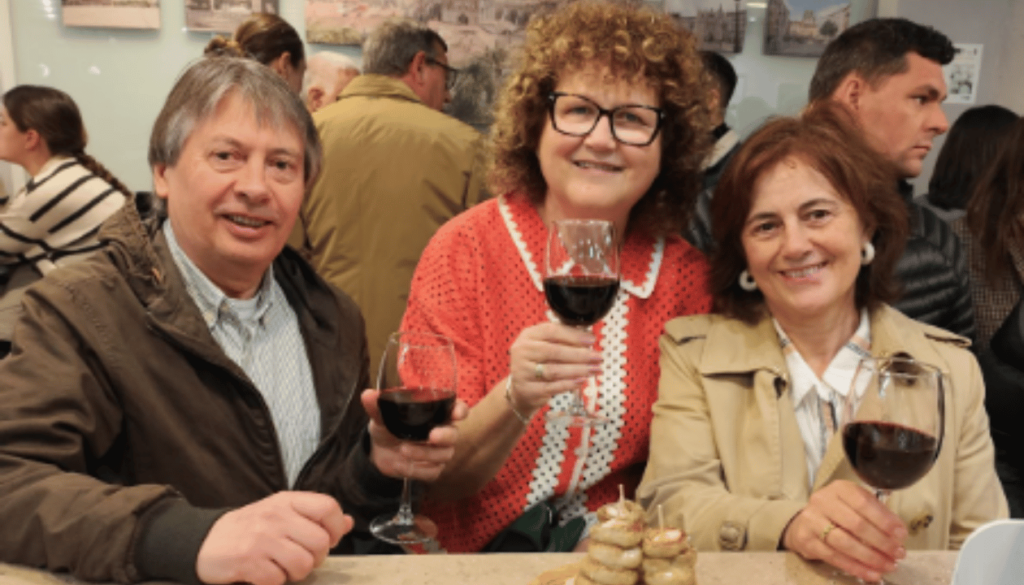
New Friends and Real Conversations in Spanish
At one spot, we ended up standing at a barrel table next to a group of local university students. They struck up a friendly conversation after hearing Belinda order in Spanish. Soon, we were all chatting about Burgos, travel, and the differences between life in Spain and life in England – all in Spanish, of course. I stood back at times just to watch Belinda comfortably carry on a conversation with her new acquaintances. It was like watching a flower bloom; she had found her footing in real Spanish social life.
A Warm Goodbye and a Night to Remember
To finish the night, I brought her to a little bar in my neighborhood where I knew the owner. There, the atmosphere was more relaxed, with older locals playing cards and chatting. The bar owner greeted us with a warm smile and asked, “¿Esta es tu estudiante?” (“Is this your student?”). Belinda proudly answered for herself, explaining in Spanish that she’d been learning all week and was celebrating her progress with a night out.
We savored one last bite – a slice of tortilla española topped with roasted red pepper – and toasted with a tiny glass of sweet licor de hierbas offered on the house. Walking home, Belinda told me that this evening was the moment she truly felt like she belonged. She wasn’t an outsider fumbling for words; she was part of the scene, chatting and laughing in Spanish. For me, that’s what these immersion programs are all about – seeing a student fully embrace the language as a living, social experience.
Gothic Art and Local Markets on the Final Day
Quiet Beauty and Royal Tombs in a Hidden Monastery
We saved Saturday for a couple of quieter, local experiences to round out the week. In the morning, we drove a short way to visit the Cartuja de Miraflores, a 15th-century Carthusian monastery set in the peaceful Fuentes Blancas park just outside the city. Compared to the bustling cathedral we’d toured earlier in the week, the Cartuja was tranquil and almost meditative.
Inside the Gothic church, we found ourselves nearly alone, gazing at the stunning altarpiece gilded in gold and the intricately carved royal tombs of an ancient king and queen. I explained in Spanish how Queen Isabella (the same queen who sent Columbus to America) had commissioned this monastery for her parents in the late 1400s, and Belinda was fascinated to connect it back to the broader history of Spain.
We spoke in hushed tones, partly out of respect and partly to soak in the calm. Belinda remarked that she loved how every day in Burgos offered a different slice of Spanish life, from lively bars to silent monasteries, and she felt comfortable in both settings.
Market Moments: Practicing Spanish Among the Stalls
On our way home, we stopped by the Saturday market that pops up near our neighborhood. Stalls brimming with fresh vegetables, fruits, and local cheeses lined the street, and the air was filled with the sing-song calls of vendors advertising their produce. This was the perfect chance for Belinda to practice some everyday Spanish in a real scenario.
She admired the stacks of shiny red peppers and giant Spanish onions, and then decided to buy some cherries to snack on. I watched proudly as she greeted the vendor with a buenos días, asked “¿Cuánto cuestan las cerezas?” (catching herself and correcting her noun gender with a grin), and even managed to banter a little about how sweet the fruit looked this season.
The friendly stall owner chuckled and encouraged her in Spanish. By the time we walked back to my house, bag of cherries in hand, Belinda had not only picked up some delicious souvenirs but also the confidence that she could navigate day-to-day tasks in Spanish, from buying produce to chatting about the weather, just like a local resident.
Adiós with Confidence: Ready for Latin America
A Farewell That Felt Like Family
As Belinda’s immersion week drew to a close, we all realized just how much had been packed into those days. When it was time to say goodbye, it felt more like seeing off a friend or family member than a student. During her stay, she had truly become part of our family – sharing our home, meeting our relatives and neighbors, and joining in every aspect of daily life. Our evening dinner conversations (completely in Spanish by the end) ranged from the next day’s plans to jokes about the funny mispronunciations she had conquered early on. Marisol and I were incredibly proud of how far Belinda had come in such a short time.
More Than Words: Real Confidence for the Road Ahead
By living and breathing Spanish here in Burgos, Belinda didn’t just improve her vocabulary and grammar; she gained the confidence to use Spanish anywhere. She told us that now she can imagine herself chatting with vendors in a Mexican market or asking for directions in the Andes without freezing up. Her original goal was to prepare for traveling across Latin America, and she left feeling that goal not only met, but exceeded.
A Walk, a Bell, and a Moment of Reflection
On our last evening, as we strolled once more along the Paseo del Espolón with the cathedral bells ringing in the background, Belinda turned to me and said in Spanish, “No sabía que podía aprender tanto en una semana” (“I didn’t know I could learn so much in one week”). The smile on her face said it all – she was speaking from the heart, in a language that a week ago still felt challenging.
One Last Wave, and the Start of Something Bigger
We waved goodbye at the station with a mix of sadness and pride. Sad to see her go, but proud knowing that another confident Spanish speaker is heading out into the world. I have no doubt she’ll make the most of her Latin American adventure, using her Spanish to unlock deeper connections with everyone she meets. And of course, Burgos will always be here waiting to hear her stories (and maybe serve her another pincho or two) when she comes back.
Your Turn: Come Live the Language With Us
Ready to take your Spanish to the next level? Join our Spanish Homestay Immersion Program (SHIP) available in Barcelona, Valencia, Cádiz, Burgos, Extremadura, and Menorca. Just like Belinda, you’ll stay with a qualified native Spanish teacher, enjoy personalized lessons, and practice the language in real-life situations every single day.

Whether you choose a 1, 2, 3, or 4-week stay, you’ll experience the rhythm of Spanish life from sharing home-cooked meals and exploring historic sites to chatting with locals at markets and cafés. SHIP is designed for travelers, professionals, students, and anyone ready to truly live the language. You won’t just learn Spanish, you’ll use it confidently, naturally, and joyfully.
Set sail with SHIP and immerse yourself in Spanish culture, conversation, and connection.

